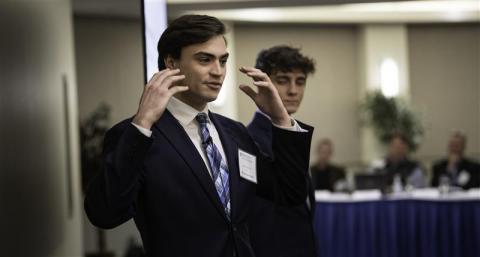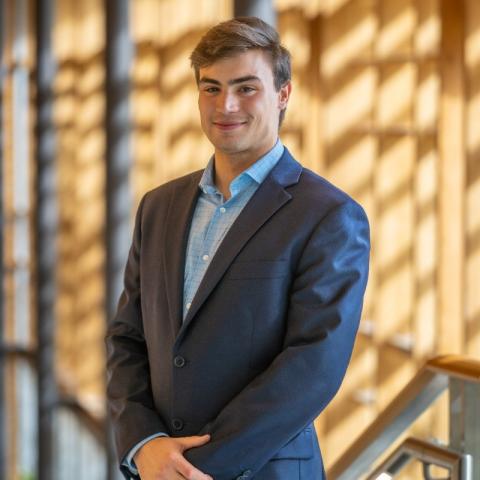Applying Classroom Learning to Real World Solutions

Nate and Miles presenting on Nacre at the 2022 SVIC.
Each year, UNH’s Changemaker Collaborative hosts the Social Venture Innovation Challenge, an idea competition. Designed for students across the state to develop solutions towards pressing social and environmental issues, the SVIC offers an array of innovative ideas to consider.
Finalists this year included sophomores Nate Brennan ‘25 (Business Administration) and his project partner, Miles Drum ‘25 (Business Administration). The pair entered the SVIC debuting a model that could increase the longevity of car tires, by using a natural resource called nacre. The product of several months of research and collaboration, “Nacre” highlighted an opportunity to prevent premature tire failure, effectively reducing waste and lowering carbon and methane emissions. Implementing the concept could increase the lifespan of tires by ten years, removing waste from the road—starting with the manufacturer.
The idea first came to Nate during a class on material science, MS 401: Science of Stuff. After reading several articles on practical uses for naturally occurring materials, he began to consider other functional applications for them.
“I was really drawn to the properties of materials,” he reflected. “My mind just ran with ideas to incorporate new resources towards a sustainable future.”
Particularly interesting to Nate was an article on nacre, the material found in mollusk shells. Lightweight yet dense, the layered structure seemed like a perfect additive for tires. Having taken environmental science shortly before, Nate was well aware of the issues of tire pollution and saw a potential fix. He and Miles conducted research on the industry and proposed the development of tires with nacre built into the side walls. The model was designed to allow tires to be more resilient, preventing wear and laceration. According to their research, if 1% of tires had nacre added, it could reduce approximately 5 billion pounds of carbon emissions, the equivalent of four Empire State Buildings.
The idea had enough merit to it that Nate and Miles were able to collaborate with Good Year Tire. The two had the opportunity to send over a write-up on their idea, with the potential for implementing it in the future. “Hearing our project had merit was the highlight for me,” reflected Nate. “I love sustainable projects and being innovative in this space.” Although the process offered some challenges, such as navigating patents and researching a model that had yet to be designed, both found it to be a rewarding experience. “Probably the biggest takeaway I got from the competition was learning about a whole new business model I had never previously been exposed to,” Miles commented.
“It's been very interesting to watch something that started as just an idea for an innovation competition develop into something that's caught the eyes of the leaders of the world's largest tire companies.”
Moving forward, the two are continuing to work with Good Year and Michelin on using nacre in rubber. By reducing waste at the developmental level, the effects will be widespread further down the road. So next time you’re in class and learn something new–try thinking to yourself, how could I use this information to solve a problem I care about?

Miles Drum '25

Nate Brennan '25